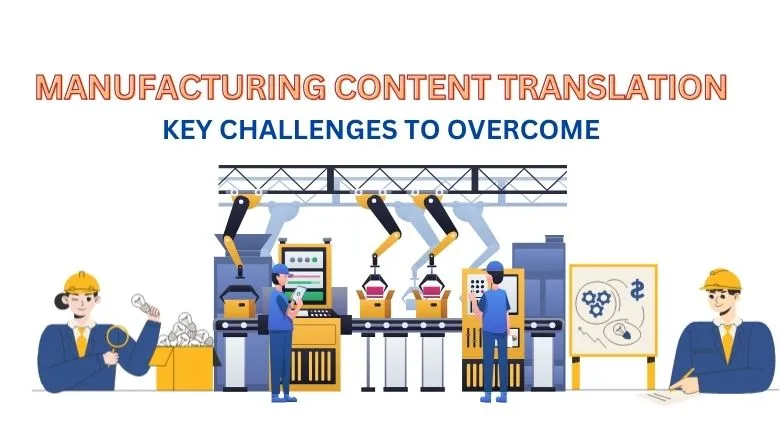 Imagine an American construction company trying to operate in France. Would it be able to operate efficiently by dispersing content in the English language? No, it won’t. Let’s find out the reason why!
Imagine an American construction company trying to operate in France. Would it be able to operate efficiently by dispersing content in the English language? No, it won’t. Let’s find out the reason why!
Let’s Explore More About This Kind of Translation
What is Manufacturing Translation?
Manufacturing translation refers to the process of converting technical and operational documents from one language to another while maintaining the original meaning, intent, and accuracy. It involves translating a wide range of materials, including user manuals, safety guidelines, standard operating procedures, product specifications, and marketing materials.
Professional manufacturing translation services require a deep understanding of industry-specific terminology, technical jargon, and the context in which the content will be used. The goal is to ensure that the translated content is as precise and functional as the original, leaving no room for misinterpretation.
Documents Included in Manufacturing Translation:
- User manuals
- Operating instructions
- Standard Operating Procedures (SOPs)
- Product descriptions
- Product packaging
- Technical documents
- Marketing materials
- Legal documents
- Training materials
- Patents
- Compliance documents
- Engineering specifications
- Quality assurance documents
Transform Your Manufacturing Content
Achieve Precision and Consistency Across Global Markets with Our Expert Translation Services!
Why Manufacturing Translation Is Important?
Manufacturing translation is vital for companies operating in a global market. It enables businesses to communicate with international partners, comply with regulatory requirements in various regions, and ensure that end-users fully understand how to operate and maintain their products safely.
Accurate translation helps build trust with customers, enhances brand credibility, and ensures that products meet the required safety and quality standards worldwide.
Key Challenges to Overcome
Technical Terminology: The Language of Precision
Manufacturing is a field where precision is important, and this extends to the language used in technical documents. Translating technical terminology requires linguistic expertise and a deep understanding of the specific manufacturing processes and technologies involved. The challenge lies in ensuring that the translated terms are accurate and familiar to the target audience.
For example, a term that is commonly used in one country might have a different connotation in another country. Ensuring consistency and precision in technical terminology is important to avoid costly errors and ensure that the translated content is functional and reliable.
Cultural Calibration: Beyond Words and Phrases
Translation involves changing the content to align with the cultural context of the target audience. This is important in manufacturing, where cultural differences can impact how certain instructions or guidelines are understood and followed. Cultural calibration involves considering local customs, idioms, and visual elements to ensure that the translated content resonates with the target audience.
This is an essential aspect of how translation services contribute to cultural exchange as it emphasizes the role of translation in bridging cultural gaps. Failure to acknowledge cultural differences can lead to confusion, misinterpretation, and non-compliance with local regulations.
Compliance Conundrum: Meeting Global Standards
Manufacturers must comply with a wide range of regulatory standards, which vary from country to country. These regulations often dictate the content and format of technical documents, safety instructions, and product labels. Translating these documents requires linguistic skills and a better understanding of the regulatory ecosystem in each target market.
The challenge is to ensure that the translated content meets all local regulatory requirements while maintaining consistency with the original documents. This often involves close collaboration with legal experts and regulatory bodies, especially in patent and trademark translation services, to ensure compliance.
Transform Your Manufacturing Content
Achieve Precision and Consistency Across Global Markets with Our Expert Translation Services!
Consistency Challenges: Maintaining the Manufacturing Message
Consistency is key in manufacturing translation, especially when dealing with large amounts of content that need to be translated into multiple languages. Inconsistent translation can lead to confusion, errors, and a lack of trust in the product. This challenge is compounded when different translators are working on different parts of a project or when updates to the original content are made after the translation has already been completed.
Therefore, it’s essential to take the help of professional translation service providers who use translation memory tools, glossaries, and style guides to ensure the same terminology and tone are used throughout the translated content, particularly in manufacturing website translation projects.
Concluding Words
Professional manufacturing translation services is a complex and challenging process that requires a deep understanding of both the industry and the languages. As manufacturers continue to expand their global reach, the need for accurate, culturally sensitive, and compliant translations will only grow.
Therefore, hire an ISO 17100:2015 certified service from Somya Translators for your translation requirements.







